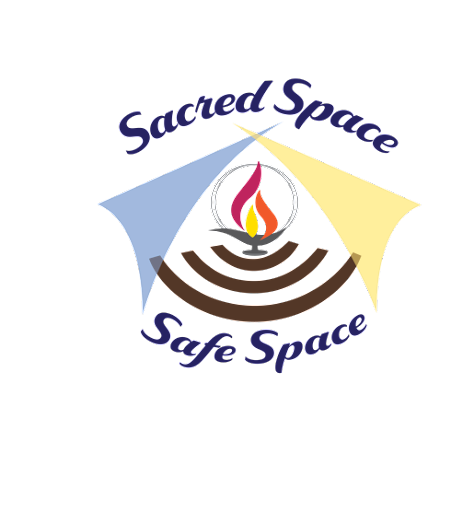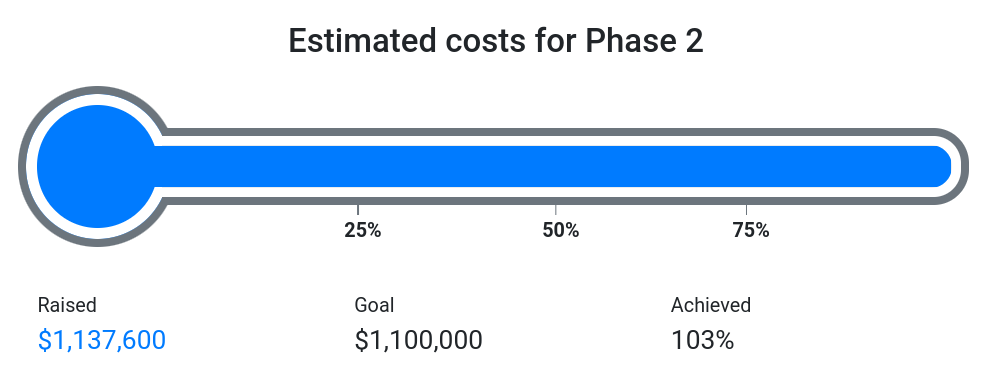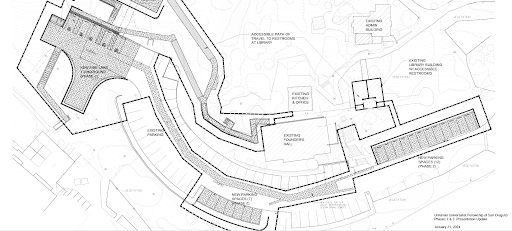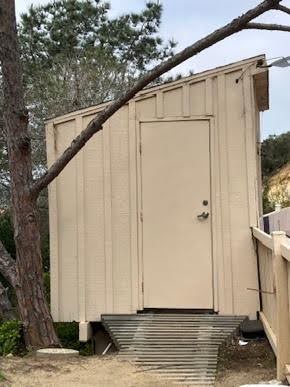- What are the phases of the capital improvement program?
Phase 1 is the repair and remodel of the Administration Building ( in progress). Phase 2 is the parking lot expansion, emergency vehicle turnaround, paths of travel to the amphitheater, and electrical and plumbing infrastructure for the amphitheater improvements. Phase 3 is the amphitheater improvements and combines the previous Phases 3 & 4.
- What is the status of Phase 1 (Admin building overhaul)?
The permit for the repair and remodel of the Administration Building was issued in November 2023 and work started immediately. Target date for completion is June 2024. A contract for $281K was awarded to Chris Kolb for this project and will include a 193ft2 expansion for a new conference room; enclosed office for our DREF/Music Director; installation of a restroom and HVAC system; new walls, roofing, windows, and floor; stucco to match the rest of the buildings; and brush management improvements around the area. This Phase is completely funded with the money available in our capital campaign fund.
- Describe the project(s) that you’re trying to fund.
Phase 2 components include an emergency vehicle turnaround, 19 additional parking spaces, 3 additional ADA parking spaces, concrete block trash enclosure, ADA compliance for paths of travel from the parking lot to the amphitheater and from Founders Hall to the amphitheater, new access stairs from our parking lot to the LePort (Montessori) parking lot, electrical/plumbing infrastructure for the amphitheater improvements, and some landscaping.
Phase 3 components include new ADA compliant concrete stairs with handrails on both sides of the amphitheater seating; new ADA compliant ramp to the first row of benches and to the platform on the west side; new concrete in the path behind the benches and the tripping hazard step removed; a new 500 ft2 building in the back to house two restrooms, AV kiosk, and storage; new concrete ADA compliant egress stairs from the west end of the amphitheater to the parking lot; shade sails, a drinking fountain, and some landscaping.
Both Phase 2 and Phase 3 require specific permits from the CA Coastal Commission and the city of Solana Beach. Our application to the CA Coastal Commission for a Coastal Development Permit was submitted in February 2024 and will cover all the planned improvements for Phase 2 and Phase 3. The application to the city of Solana Beach was also submitted in February 2024, but only for the building and grading permits for improvements planned for Phase 2. Because our architect, Doug Paterson, has been in constant communication with both of these governmental agencies throughout preparing the applications, we expect the permitting process to go smoothly and to have the permits we need to begin Phase 2 construction issued by mid summer 2024.
- What aspects of Phases 2 and 3 are mandatory and which are optional?
In Phase 2, all the components are required except for the electrical/plumbing infrastructure for the future amphitheater improvements and the new access stairs to the LePort parking lot. Per mandate of the county Fire Marshall, we are specifically required to complete the emergency vehicle turnaround before any other improvements can be done. We have an official, reciprocal agreement with the LePort school to share our parking lots, and the current access stairs will not be accessible with the emergency vehicle turnaround installation.
In Phase 3, all the components are required except the shade sails and the new AV kiosk and storage rooms.
- How will safety and accessibility be improved in Phase 2?
An emergency vehicle cannot turn around in our current parking lot. The only option is for the vehicle to literally back up. Because of this, the county Fire Marshal has declared that our property does not have adequate fire access, and therefore mandates that we install an emergency vehicle turnaround. Having this turnaround not only improves our safety to control future fire situations, but also improves response times to transport a critically injured person to a nearby hospital.
Both walkways from Founders’ Hall to the greeters table and from the parking lot to the lower ramp will be ADA compliant and completely redone with concrete and handrails. The lower and upper bridges will also have new handrails.
- What impacts will there be on parking and access during construction?
The contractors will be required to develop a plan to work on the parking lot in stages to ensure that access is preserved to the areas that aren’t under construction. Details will become available once a contractor is in place.
- What happens if we don’t do Phase 2?
Phase 2 provides safety and accessibility infrastructure for the campus. Without it, we will never be able to make any improvements elsewhere on our site, including the amphitheater, because we will be out of compliance with ADA and safety requirements. More importantly, our walkways will continue to deteriorate and become even more challenging for anyone traversing the campus (like people with strollers or walkers, staff with equipment carts, etc.). And even more important than that, emergency vehicles will not be able to easily access the west end of the campus (ie, the amphitheater) in case of an emergency because they can’t turn around in our parking lot.
- What happens if we don’t do Phase 3?
Phase 3 includes all the amphitheater improvements, including accessible ramps and handrails to get to the lower part of the amphitheater, a new kiosk with bathrooms and space for the A/V equipment and staff, and shade sails to protect from the sun. Some elements are required for ADA compliance and safety; others may be optional (ie, shade sails). If we don’t do Phase 3, the amphitheater will continue to deteriorate and be unsafe. Among other impacts, we will not be able to welcome anyone with mobility challenges; attendees will be limited to the existing bathrooms under the library (a problem for young and old); it will be harder to provide adequate A/V support; and we could miss out on potentially significant rental income. And finally, we will not be fulfilling our promises to the earlier donors who gave money with the understanding that the amphitheater improvements were the main goal of the first capital campaign.
- What is the timeline for completing each phase?
TBD
- How much money do we need, and when do we need it?
TBD
- Why do we need a capital campaign and how does it relate to the Annual pledge drive?
The annual pledge drive provides the money needed to operate our Fellowship – salaries, utilities, supplies. etc. Think of it as money you’d spend each month from your income or checking account. The Board creates a budget for the coming year based on pledges, or commitments, from members, and then spends the funds as the pledges are paid. This is an annual cycle.
The capital campaign is for big, one-time expenses. Others before us gave time and money and labor to build the facilities we have. We have an obligation to care for and improve what we were given for those who come after us. Think of this as coming out of your savings account or your reserves – like if your house needed a new roof or buying a new car. You might make payments over time, but it’s not an expenditure you make every year. We have already taken care of long-overdue maintenance and upgrades on the existing parking lot, classrooms, administration building, kitchen, main stairway, bridges, and Founders Hall. The amphitheater is the final phase of this once-in-a-generation capital program.
We expect to be inviting members to make a financial contribution at the start of the campaign to enable us to proceed with the safety and accessibility infrastructure work in Phase 2, and then a multi-year commitment to fund the amphitheater improvement work, which won’t start until Phase 2 is at least underway.
At this point in the life of our Fellowship, it is clear that we need both – annual pledge payments to fund our ongoing operations, staff, and programs, and a final push for capital funds to complete the work of making our campus safe, accessible, and comfortable for us and for future generations.
- What has been accomplished in the last 10 years to improve the campus?
Much has been done to make our campus safer and more structurally sound for the future. Our dirt parking lot is now permeable pavement; all four RE classrooms have been upgraded to meet code and made safer; the Core Building has been remodeled and the kitchen redone; the existing bathrooms have been upgraded; an operable partition wall has been installed in Founders’ Hall; ramp improvements were made in the upper parking lot; new concrete entry stairs were installed; and many campus security improvements thru a Cal OES grant from FEMA (wireless motion cameras, solar powered kiosk, electronic door entry devices).
- Have we tried to get outside funding to help?
Yes, and we have succeeded. We received $350,000 from the Spirit Level Foundation, a local UU organization, in our original capital campaign, and another $50,000 for the Phase 2 safety improvements. We are always looking for other potential sources of finding, and if anyone has suggestions, let us know.
- Can we borrow from the UUA?
The UUA does have a loan program. If the Board and congregation want to take on debt, we would have to pay our full “Fair Share” of UUA dues to become an “honor congregation” and make sure we had the income stream to make payments on the debt. We would be expected to be an “honor congregation” throughout the term of our loan. We would prefer to raise the money from donations and not have a mortgage if possible.
- Why are you always asking for money?
It may seem like we are always asking for money. The reality is that each UU congregation is autonomous, financially, and we, the members, are responsible for providing the resources needed to support our Fellowship. Members are strongly encouraged to make an annual contribution to our operating expenses through their pledge. The capital campaign has taken a long time, but it only happens rarely. Other asks, like Generosity Sundays, are opportunities for members to experience the satisfaction of supporting worthwhile organizations, but giving is entirely optional.
The “you” who is asking for money is really “us.” Volunteer members of the congregation comprise the Finance Committee, the Board, the Stewardship Team, and the Capital Campaign Team, among all the other groups and committees at UUFSD. We are asking ourselves to support and maintain our spiritual home. If we want to attract and retain good ministers and staff, we need to be able to offer fair compensation and safe working conditions. If we want to attract members, we need quality services and programs and a comfortable, safe, accessible campus. This can only happen if we have the requisite funds.
Sacred Space, Safe Space

- About
- Phase 2 – Safety, Accessibility & Infrastructure
- Phase 3 – Amphitheater
- Become an Investor
- Frequently Asked Questions
Your opportunity to invest in the future of UUFSD
ABOUT
Thanks for the founders of UUFSD and many who came after them, we have been given a unique and extraordinary campus for our beloved community. But after more than sixty years, even when the foundation of love is solid, cracks can appear in the asphalt and concrete of our physical space. As our congregation has evolved, so have our needs, as well as the rules and requirements for safety, accessibility, environmental protection, and sustainability.
Over the past ten years, as much of the existing UUFSD campus was reaching the limit of its design life, we came together and invested in much needed maintenance and improvements, bringing the classrooms, kitchen, stairway, bridges, and the administration building up to current safety standards.
See the recent improvements HERE
Now we have the opportunity to complete our campus renovation, ensuring that our sacred space will be a safe, accessible, sustainable, and welcoming space for now and for those who come after us.

WHAT’S NEXT?
Phase 2 – SAFETY, ACCESSIBILITY & INFRASTRUCTURE
Unlocking the door to amphitheater improvements
All needed approvals and permits will be in hand and construction could begin by Sept. 15, 2024.
ALL THAT IS NEEDED IS THE FUNDS!

The UUFSD campus was established before the City of Solana Beach was incorporated, before California established the California Coastal Commission, and before the Americans with Disabilities Act became law. Much of our campus has been out of compliance with current requirements. When we start our renovations and upgrades, we are obliged to bring the whole campus up to current safety, accessibility, and environmental requirements.
While this seems to some to be a burden, and while it definitely imposes costs, it also makes us safer from fire hazards, more accessible for people with mobility limitations, and reduces the time it takes for first responders to reach someone in an emergency. We will not be able to proceed with amphitheater improvements until we complete most of the elements in this phase. It truly does UNLOCK THE DOOR TO THE AMPHITHEATER IMPROVEMENTS that we all long for.
Specifically, this phase includes:
- Expanding the west end of the parking lot to enable an emergency vehicle to turn around. If there was an incident in the amphitheater, the first responders’ vehicle would only be able to go as far as the main stairway, wasting precious time in reaching the person in need (required)
- 19 additional parking spaces (required)
- 3 additional ADA parking spaces (required)
- Trash enclosure (required)
- Bringing all our paths of travel to the amphitheater from Founders’ Hall and from the parking lot up to ADA standards, replacing irregular, steep ramps (required)
- New stairs between our parking lot and Montessori school
- Plumbing/electrical infrastructure for planned amphitheater improvements so we don’t have to go back and dig up the parking lot after Phase 2 is completed.

Click on the image above to see the complete set of drawings.
Phase 3 – AMPHITHEATER
Once Phase 2 is completed, we can move forward with our long-term goal of making the beloved amphitheater, the jewel of our campus, safer, more functional, more accessible, and more comfortable. Not only will this enhance our worship experience on Sundays but it will make the space attractive for special events and increase opportunities for rental income.
Specifically, this phase includes:

- ADA compliant concrete stairs with handrails on both sides of the amphitheater seating
- ADA compliant ramp to the first row of benches and to the platform on the west side
- Step removed in the back of the amphitheater
- Places for wheelchairs in first and back row
- Shade sails
- Nice, large ADA compliant restrooms
- New AV kiosk and storage room
CAN WE REALLY DO THIS? IS NOW THE RIGHT TIME?
Working together, we can assure that our fellowship is a safe, accessible place for our children and our respected elders, a place that takes into account people with all needs, be it the need for wheelchair access or the need to stay out of the sun during services.
This is our chance, here and now, to build our legacy from the ground up, while taking care not to tread too heavily on the earth with our own footprint, nor trample on the footprints that our elders, our founders, have left before us.
It has been a long and bumpy journey to get to this point. We are now ready to go with a plan that has been revised, reviewed, and finally has met and conquered all the obstacles, so we know we have met all the requirements. The only thing we need now is funding.
It is up to us. Will you invest in the future of UUFSD, to ensure our ability to continue welcoming, worshiping, and working together to put our values into action in a world that needs us?
THANKS TO OUR INVESTORs
THANKS TO YOU, WE HAVE THE FUNDS FOR PHASE 2!
THANKS TO YOU, WE HAVE THE FUNDS FOR PHASE 2!


